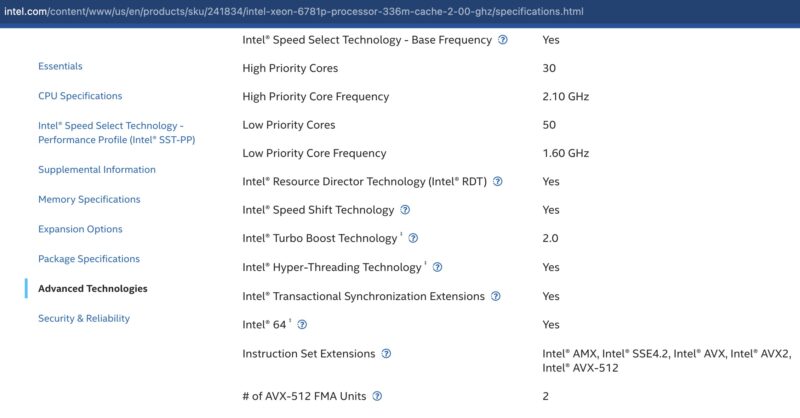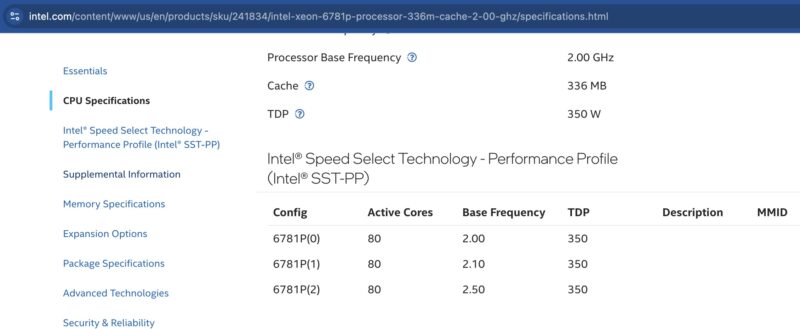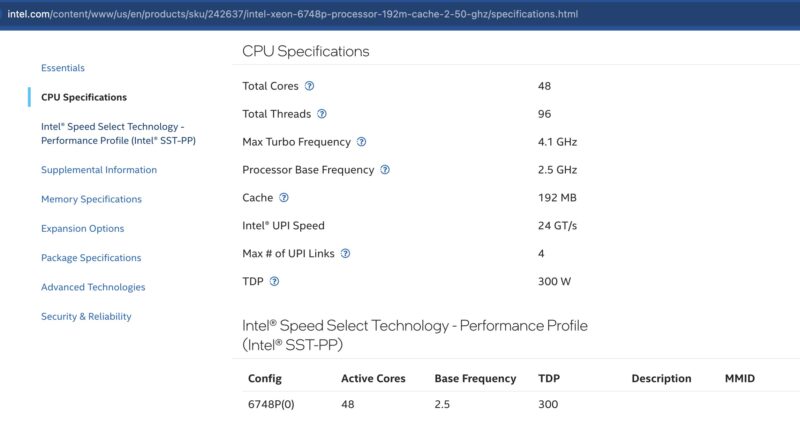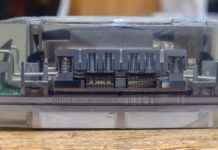The Intel Xeon 6700P “Granite Rapids-SP” has some SKUs with a feature splitting cores into high-priority and low-priority cores. What is more, there are core counts where one SKU may not have the split while two other SKUs have different numbers of high-priority and low-priority cores. This is one we had a few readers spot in the latest specs, and there were quite a few rumors swirling around that this might mean there are E-cores on some Granite Rapids-SP parts (there are not), so we wanted to clear it up for folks.
Intel Xeon 6 High-Priority and Low-Priority Cores Explained
If you go to specs of a number of CPUs, you will see that the new Ark pages at Intel have high-priority and low-priority cores with usually fewer high-priority cores and a higher base frequency listed. Since we used the Intel Xeon 6781P for our Intel Xeon 6700P and 6500P Granite Rapids-SP launch piece, we are going to use that 80-core processor as an example. Here is the relevant section on Intel Ark:

As you can see, there are 30 High Priority Cores with a 2.10GHz Core Frequency while there are 50 Low Priority Cores at a Core Frequency of 1.60GHz. This has caused rumors to swirl on what that might mean, especially since it is not on all SKUs and there are now E-core only lines like the Xeon 6700E and heterogeneous desktop processors.
To understand what is going on here, let us take a step back to the normal CPU setup, and how we normally use CPUs. Here, we have 80 cores all at a 2.0GHz base frequency. Intel has a feature called “SST-BF” or Intel Speed Step Technology Base Frequency that allows one to configure a processor to have some cores with higher base frequencies and some with lower base frequencies. So in the Intel Xeon 6781P example above, instead of running at 2.0GHz base, the High Priority Cores run 5% faster at 2.1GHz. To offset. the additional power being used by that slightly higher resting clock speed, the Low Priority Cores run at a base frequency of 1.6GHz.
The idea is that as CPU core counts get larger, some workloads can run on a set of cores that are already at a higher clock speed to improve responsiveness, especially when a system is lightly loaded. This is in some ways like a base frequency version of Intel’s high-utilization technologies like Intel Speed Select Technology Core Power and Intel Speed Select Technology Turbo Frequency that allow certain cores to run faster in loaded systems.
While that may seem simple, there are at least two good wrinkles to this.
Intel Xeon 6700P – Intel Speed Step Technology Base Frequency Wrinkles
The first wrinkle is the obvious. That same Intel Xeon 6781P also supports Intel Speed Select Technology Performance Profile or SST-PP. If we look at that table, we can see our Profile (0) state is our base case with the 2.0GHz.

The Profile (1), however, has the base frequency of 2.10GHz and the Profile (2) has the base frequency of 2.50GHz. If you do not know the SST-PP it is actually one we have used a bit and it is very cool. On some Intel SKUs you can select if you want, for example, more cores at lower clock speeds or fewer cores but at higher clock speeds. For companies ranging from enterprises buying on fixed configuration contracts that are discounted on volume per configuration to cloud providers who want to deploy one configuration and then sell multiple CPU options, this is a useful feature. You might, for example, wonder why one would not just pick Profile (2) and get a 2.5GHz base frequency instead of having 2.1GHz on 30 cores and 1.6GHz on 50 cores. The reason there likely comes down to power, but that is not a necessarily invalid thought.
The second wrinkle, is that this feature is not consistent. Here is an example from 64 core SKUs where the:
- Intel Xeon 6768P has 16 High Priority and 48 Low Priority cores
- Intel Xeon 6767P has 24 High Priority and 40 Low Priority cores
- Intel Xeon 6761P has 24 High Priority and 40 Low Priority cores
- Intel Xeon 6760P does not have the prioritization
- Intel Xeon 6748P has 16 High Priority and 32 Low Priority cores
- Intel Xeon 6747P does not have the prioritization
- Intel Xeon 6741P has 12 High Priority and 36 Low Priority cores
- Intel Xeon 6740P does not have the prioritization
Again, that is four SKUs and three different prioritization schemes among them. Making things a bit different is that not all of these SKUs are like the Intel Xeon 6781P above with many different SST-PP options that might make the distinction moot in some minds. For example, the Intel Xeon 6748P has only SST-PP (0):

So the 2.5GHz is the base frequency. Unless you have SST-BF where the 32 Low Priority cores run at 800MHz.
Final Words
Sometimes SST-PP is useful for us to try different core counts quickly without having to swap CPUs, but we also run a lab environment. Normally, we test CPUs and servers using their base profiles, and our guess is that most folks do not utilize these features. Just to give you some sense, this feature we actually first came across in the 2nd Gen Intel Xeon Scalable “Cascade Lake” networking SKUs that had a “N” suffix. It has been around so long that there are even tools for OpenStack to utilize these features.
It seems like Intel simplified its SKU stack by removing the “N” network-optimized parts with the SST-BF feature, and added it to more standard SKUs. As a result, folks are looking at the specs and are getting confused because they were not previously “N” SKU customers that have been buying and using this feature for generations.
For most of our readers, we are just going to advise that they skip those lines in the spec tables. If you are interested, Intel has lots of SST-BF documentation once you know what to look for.





Dear Patrick
Thank you for your answer. I might not have used Intel Xeon products for a while, so I’m not familiar with them.
Great explanation for those who are not familiar with Intel Speed Selection Technology.
Just additional remark here – telco workloads dont use turbo. Everything is set to max performance. This is done to avoid latency and jitter. Still in this area there are workloads with differring needs for CPU perf. This feature helps in matching that, while retaining hardware uniformity.
I have servers in the cloud. I pay for cores. How do I know whether they are high priority cores or low priority cores?
This is one of those articles that makes it worth following STH.
Good job!